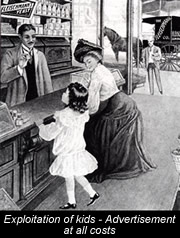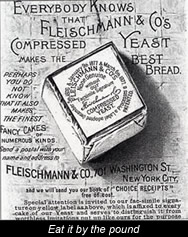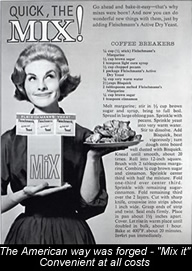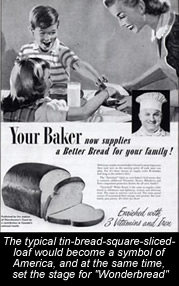|
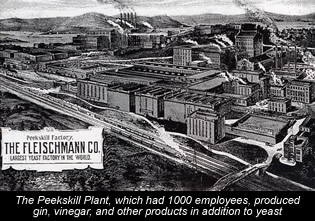 This new process became known as the Viennese production of yeast, and is still used today as the industry standard. From a single yeast cell it is possible to produce 40 tons of pure yeast within 10 days. It is needless to say that the profit potential was enormous in light of such yields. This new process became known as the Viennese production of yeast, and is still used today as the industry standard. From a single yeast cell it is possible to produce 40 tons of pure yeast within 10 days. It is needless to say that the profit potential was enormous in light of such yields.

Historically, bakery products were much more limited in variety and fermentation was mainly achieved by the sourdough method, which involved using the excess yeast that was produced during the brewing of beer or distillation alcohol. This is why the baking and brewing crafts have had such an intimate relationship from ancient times.

 Mr. Fleischmann patented several of his own inventions in the United States, and together with his brothers Max and Henry, they built an empire based on fermentation in the industrial heartland of America. In 1870 they built the first yeast plant adjacent to the Baltimore and Ohio Railroad and Ohio River at Riverside, just outside Cincinnati. This facilitated rapid transport of raw materials and finished products. At first sluggish to start with, their yeast market turning point came when the Fleischmann brothers attended the Centennial Exposition held in Philadelphia from May to November of 1876. This world fair was a celebration of the arts of the Industrial Revolution, and attracted 10 million visitors. With his Vienna model bakery concession where Mr. Fleischmann demonstrated the yeast leavening process, baked bread, and Viennese pastries, he provided the platform that catapulted the Fleischmann dynasty into the future. From this time on advertisement became a vocal point and tool of marketing and shaped as well as symbolized the new marketing strategy of modern business. Since then these strategies have exploited children and family values to the extreme; there are no limits set and unethical sales gimmicks abound with no sanctities whatsoever. Mr. Fleischmann patented several of his own inventions in the United States, and together with his brothers Max and Henry, they built an empire based on fermentation in the industrial heartland of America. In 1870 they built the first yeast plant adjacent to the Baltimore and Ohio Railroad and Ohio River at Riverside, just outside Cincinnati. This facilitated rapid transport of raw materials and finished products. At first sluggish to start with, their yeast market turning point came when the Fleischmann brothers attended the Centennial Exposition held in Philadelphia from May to November of 1876. This world fair was a celebration of the arts of the Industrial Revolution, and attracted 10 million visitors. With his Vienna model bakery concession where Mr. Fleischmann demonstrated the yeast leavening process, baked bread, and Viennese pastries, he provided the platform that catapulted the Fleischmann dynasty into the future. From this time on advertisement became a vocal point and tool of marketing and shaped as well as symbolized the new marketing strategy of modern business. Since then these strategies have exploited children and family values to the extreme; there are no limits set and unethical sales gimmicks abound with no sanctities whatsoever.

By the 1890’s Charles Fleischmann had four production plants, several luxurious vacation homes, a yacht, a stable of racehorses, and was a state senator. He was also close friends with William McKinley, who eventually became president of the United States from 1897 to 1901. The enormous mansions built one after another in the following 50 years by the Fleischmann dynasty were truly astronomical, and all based on this microscopic organism.

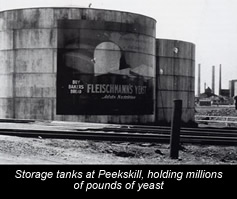
|
In 1900 the gigantic Peekskill factory at Charles Point on the Hudson River, New York, was built and employed close to 1,000 employees producing train loads of gin, huge amounts of vinegar and other products in addition to millions of pounds of yeast. In 1905 the Fleischman Company had 12 plants, employed 1000 salesmen servicing 30,000 bakeries, and 225,000 grocery stores.

The exploitation of the yeast cell culminated into the eventual marketing of yeast cakes for direct consumption by the public. The marketing campaign involved heart-rending testimonials from consumers, as well as authoritative prescriptions by European doctors for diverse ailments such as teenage pimples, intestinal disorders, natural laxatives, and purifiers, etc. Even a radio Fleischmann hour ran from 1929 to 1939 and became very popular. A questionnaire survey of 30,000 American doctors showed that nearly half said they had prescribed yeast at some time or another, which became the physician-touted “purification by yeast”. This run-away blasphemy finally came to an end when these claims were examined by recognized health authorities. Modern yeast allergies are very common and it leaves one wondering about the connections to the abusive intake of pure yeast in the past and the overload of yeasted products of today. However, the name Fleischmann became synonymous with the ascent of America, and by 1938 the company served 60,000 bakeries and restaurants, and 300,000 grocers with a fleet of 3,000 vehicles.
|
|


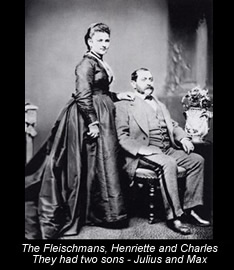 The ever genius mind of man was at the height of inventiveness during the Industrial Revolution. The combination of scientific breakthroughs and technological advances of machinery were absolutely necessary for the birth of mass production. This laid the groundwork for some of the greatest innovations that helped shape society today. Being at the right place at the right time coupled with enough entrepreneurial skill and vision could make a person a success beyond wildest imagination; especially in the “Land of Opportunity” as the New World that America had become.
The ever genius mind of man was at the height of inventiveness during the Industrial Revolution. The combination of scientific breakthroughs and technological advances of machinery were absolutely necessary for the birth of mass production. This laid the groundwork for some of the greatest innovations that helped shape society today. Being at the right place at the right time coupled with enough entrepreneurial skill and vision could make a person a success beyond wildest imagination; especially in the “Land of Opportunity” as the New World that America had become. 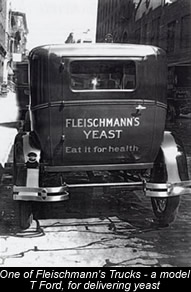
 This new process became known as the Viennese production of yeast, and is still used today as the industry standard. From a single yeast cell it is possible to produce 40 tons of pure yeast within 10 days. It is needless to say that the profit potential was enormous in light of such yields.
This new process became known as the Viennese production of yeast, and is still used today as the industry standard. From a single yeast cell it is possible to produce 40 tons of pure yeast within 10 days. It is needless to say that the profit potential was enormous in light of such yields.  Mr. Fleischmann patented several of his own inventions in the United States, and together with his brothers Max and Henry, they built an empire based on fermentation in the industrial heartland of America. In 1870 they built the first yeast plant adjacent to the Baltimore and Ohio Railroad and Ohio River at Riverside, just outside Cincinnati. This facilitated rapid transport of raw materials and finished products. At first sluggish to start with, their yeast market turning point came when the Fleischmann brothers attended the Centennial Exposition held in Philadelphia from May to November of 1876. This world fair was a celebration of the arts of the Industrial Revolution, and attracted 10 million visitors. With his Vienna model bakery concession where Mr. Fleischmann demonstrated the yeast leavening process, baked bread, and Viennese pastries, he provided the platform that catapulted the Fleischmann dynasty into the future. From this time on advertisement became a vocal point and tool of marketing and shaped as well as symbolized the new marketing strategy of modern business. Since then these strategies have exploited children and family values to the extreme; there are no limits set and unethical sales gimmicks abound with no sanctities whatsoever.
Mr. Fleischmann patented several of his own inventions in the United States, and together with his brothers Max and Henry, they built an empire based on fermentation in the industrial heartland of America. In 1870 they built the first yeast plant adjacent to the Baltimore and Ohio Railroad and Ohio River at Riverside, just outside Cincinnati. This facilitated rapid transport of raw materials and finished products. At first sluggish to start with, their yeast market turning point came when the Fleischmann brothers attended the Centennial Exposition held in Philadelphia from May to November of 1876. This world fair was a celebration of the arts of the Industrial Revolution, and attracted 10 million visitors. With his Vienna model bakery concession where Mr. Fleischmann demonstrated the yeast leavening process, baked bread, and Viennese pastries, he provided the platform that catapulted the Fleischmann dynasty into the future. From this time on advertisement became a vocal point and tool of marketing and shaped as well as symbolized the new marketing strategy of modern business. Since then these strategies have exploited children and family values to the extreme; there are no limits set and unethical sales gimmicks abound with no sanctities whatsoever.
